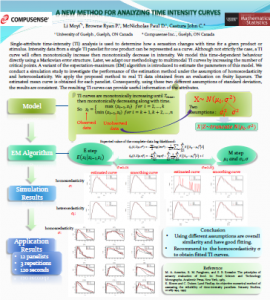A new method for analyzing time intensity curves based on the gamma distribution
 Single-attribute time-intensity (TI) analysis is used to determine how a sensation changes with time for a given product or stimulus. Intensity data from a single TI panellist can be represented as a curve, which is roughly concave down but may be irregular or skewed. Depending on the system, a TI curve might display multiple peaks, but in some cases TI curves are observed to be monotonic increasing and then monotonic decreasing in intensity. To model such curves, we propose using a time-dependent structure. An interesting and important problem is finding a TI curve that is in some sense representative of all panellists, and being in some sense characteristic of the product under study. The purpose of this research is to estimate the mean and standard deviation for a TI curve across the entire panel. For each panellist, the mean and standard deviation at each time point are estimated via EM algorithm. A simulation study is conducted to test the performance of the estimation method. Principal variance component analysis (PVCA) is used to analyze variation across panellists, so that a gamma distribution-based mixture model can be fitted. Once analysis is complete, the information contained in the TI curves can be distilled to shape and location parameters, enabling straightforward comparison of products.
Single-attribute time-intensity (TI) analysis is used to determine how a sensation changes with time for a given product or stimulus. Intensity data from a single TI panellist can be represented as a curve, which is roughly concave down but may be irregular or skewed. Depending on the system, a TI curve might display multiple peaks, but in some cases TI curves are observed to be monotonic increasing and then monotonic decreasing in intensity. To model such curves, we propose using a time-dependent structure. An interesting and important problem is finding a TI curve that is in some sense representative of all panellists, and being in some sense characteristic of the product under study. The purpose of this research is to estimate the mean and standard deviation for a TI curve across the entire panel. For each panellist, the mean and standard deviation at each time point are estimated via EM algorithm. A simulation study is conducted to test the performance of the estimation method. Principal variance component analysis (PVCA) is used to analyze variation across panellists, so that a gamma distribution-based mixture model can be fitted. Once analysis is complete, the information contained in the TI curves can be distilled to shape and location parameters, enabling straightforward comparison of products.
![]()
Li, M., Browne, R. P., McNicholas, P. D., & Castura, J. C. (2012). A new method for analyzing time intensity curves based on the gamma distribution. Canadian Institute of Food Science and Technology 50th National Conference. 27-29 May. Niagara Falls, ON, Canada. (Poster).